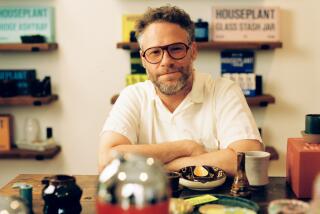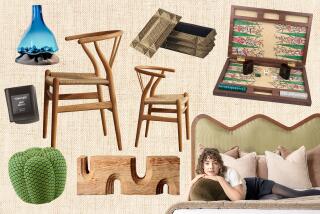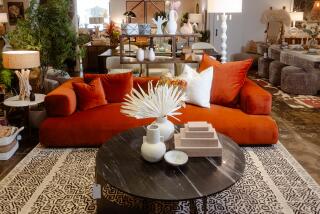Partners in Style : An Interior Designer, a Sculptor and an Aeronautical Engineer Combine Forces to Create Piage Furniture
Everyone told Sean Afshar he was crazy to leave a well-paying job at Douglas Aircraft to design and sell furniture. But then, they all laughed at Christopher Columbus, too.
Afshar had left his native Iran 14 years earlier to study aeronautical engineering in England. He came to America in 1978, joined Douglas in 1979 and left in January, 1986, with enough certificates to wallpaper a small kitchen--certificates of merit in engineering, certificates for making profitable employee suggestions, and yet more certificates for helping to run the McDonnell Douglas Project Love Foundation, which provides gifts for American Indian children.
Since he left, he has had two offers from other aerospace firms for jobs at more than $100,000 a year, and Douglas has asked him to return; but the furniture business that Afshar opened at 511 N. Robertson Blvd., West Hollywood, with his brother Abdi and his brother-in-law Abi Ghorbani, is so successful that Afshar is not tempted.
The three partners call their business Piage. Originally, they were going to give it a more highfalutin name, Paradise International Art Gallery Enterprises, but they boiled that down to its initial letters, which formed a snappier, more elegant name.
Sean and Abdi are among the Iranians who got out of Iran before the shahâs downfall. Their parents also live in Los Angeles. Abdi left Iran 12 years ago and studied interior design at the University of San Franciscoâs Academy of Art. Their sister Feri, a well-known textile designer in the shahâs Iran, is married to Ghorbani, former scenery director of the Tehran Opera House (he was fired immediately after the Iranian revolution). Ghorbani is also a sculptor of alabaster-white statues, which, though semi-abstract, unmistakably suggest the female figure.
Early in 1985, Abi and Abdi started discussing the idea of setting up an art gallery together. Sean, who was then still at Douglas, got involved in the discussion one evening when he was visiting his sister.
âWell, when are you going to start this business that youâve been talking about?â Sean asked.
âWeâre going to do it one day,â Ghorbani said.
Sean said, âNo, weâre going to start it today. â
That was in April of last year. Sean was heavily involved in setting up the firm in his spare time, although he did not leave Douglas for some months. The three men started with a studio in Downey. In the first few months they designed and made prototypes of most of the furniture they sell today. All three agree that the designs are achieved by teamwork. âYou could not say: âThis lamp is by Abi, or this table is by Sean,â â says Abdi. Sean describes their wares as âprimitive modern.â
The Piage style is the result of an extraordinary coalition between ancient and modern. On the one hand, certain spiraling, ridged and pinnacled forms suggest the influence of Islamic architecture, and some delicate decoration brings to mind the fastidious lines of Persian miniature paintings and the sybaritic courts described by Persian poet Omar Khayyam. On the other hand, Sean Afshar has brought to the work some of the techniques he acquired as an aeronautical engineer, such as producing a three-dimensional computer rendering from a slight sketch. The teamwork concept also stems from Seanâs aircraft-design experience; at Douglas, he had been part of a team restoring a 50-year-old DC-2, one of the first airliners built by Douglas.
âOur furniture is sculpture,â Sean claims. About half the pieces are handmade. Most of the rest are made in casting-stone, a material softer than concrete but harder than plaster. An original model is created in plaster; a mold is taken from it, and the casting-stone is poured in. Every piece has a hand-painted finish. You might think that some of the furniture was of casting-stone poured into log-shaped molds; you would be wrong. It is of wood, painted gray to look like stone.
Piage makes wall and floor surfaces in keeping with its furniture range--mealy, earthy, undemonstrative. One of their customers, Pat Pfaffenbach, is an interior designer who is opening a shop in Westfield, N.J. She had been attracted by âthe beautiful natural color of the stone,â she explained. âLots of people on the East Coast have what they call âthe Southwest taste,â which is for natural materials, bleached finishes and terra-cotta floors. But itâs not easy to find. Iâm here on a research trip, to see what kinds of thing Iâd like to carry in my shop. And I think Iâve found them at Piage.â
Sean, who is a member of the American Society of Interior Designers, estimates that 60% of his clientele is residential, 40% commercial. âSometimes when we walk in in the mornings, someone is behind us--this has happened a few times,â Sean says. âThey say: âI was passing here last night. I saw this lamp. I would love to have it.â â One such casual caller recently was Diahann Carroll of âDynasty,â who, Sean says, âbought up half the shop.â
Sean Afshar spends half his time traveling on behalf of the firm. In April he flew to Phoenix to promote the Piage range. On the airplane he noticed a man across the aisle in civilian clothes wearing a pilotâs âwingsâ pin. Sean told the man that he himself flies small aircraft for fun and also mentioned his experience with Douglas. A woman seated nearby introduced herself. She was Sharon Maggard, of McDonnell Douglas Corp. Helicopter Co. in Mesa, Ariz. Sean told her about his new enterprise--the furniture, the sculptures--and showed her the Piage catalogue. Maggard said there were plans to commission a sculpture of an Apache on a horse to go above the helicopter plant entrance.
So Sean extended his stay in Phoenix by two days and had two meetings with the helicopter companyâs executives. Piage has since made a proposal to create the sculpture; the proposal is under consideration. âAnd I am optimistic,â Sean says. âIt seems that every time I travel on an airplane, I sell something.â
More to Read
Inside the business of entertainment
The Wide Shot brings you news, analysis and insights on everything from streaming wars to production â and what it all means for the future.
You may occasionally receive promotional content from the Los Angeles Times.










